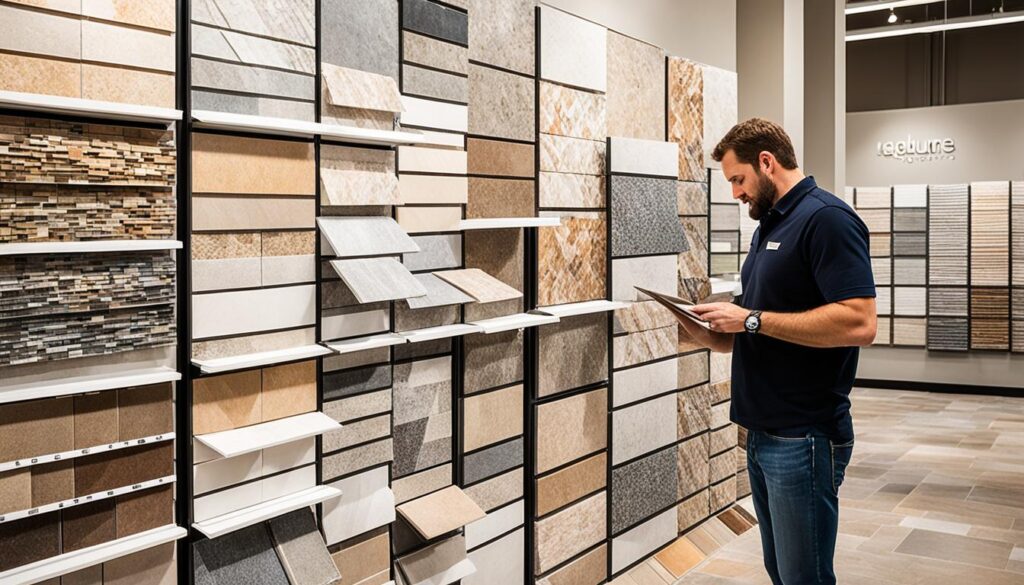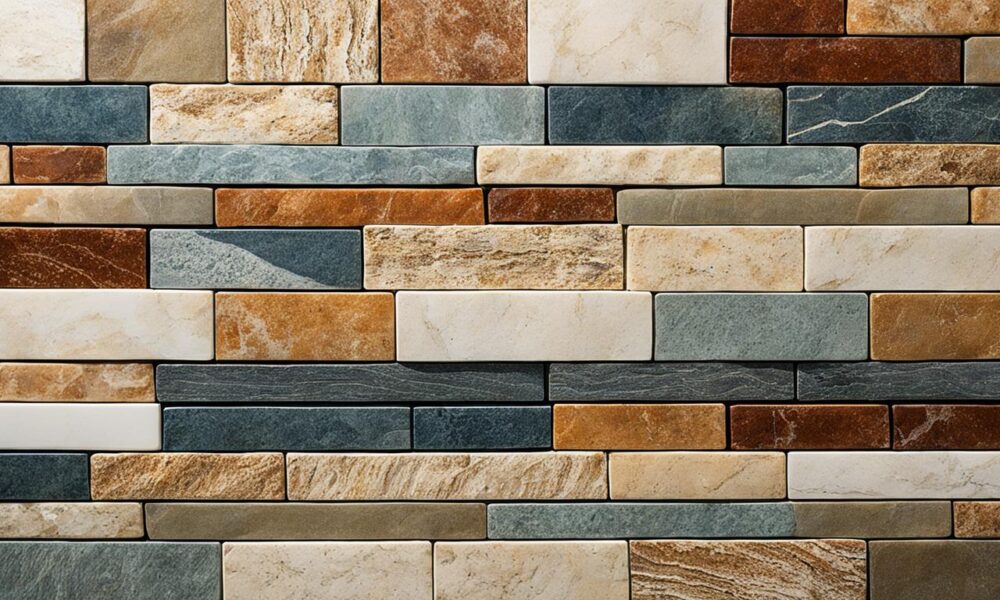How to Choose the Best Natural Stone Tiles for Your Home
Natural stone tiles are a top pick for home upgrades. They’re loved for being long-lasting, beautiful, and never going out of style1. You’ll find many kinds, like granite, marble, and more. Picking the right one can seem overwhelming1.
Think about your home’s overall look, the local weather, and how much care you can give. For busy areas and outside, granite and quartzite shine. They last long and stay looking good2. Marble adds a touch of class inside but needs more care because it’s soft2.
Travertine and limestone bring the outside in, looking earthy and textured. Travertine is a common choice for various uses indoors and out1. But, these materials get stained easily and need sealing32.
Slate can go on floors, walls, and even roofs. It’s tough and has a unique, rustic vibe. Perfect for places that get wet, it keeps you from slipping. However, it can chip and needs sealing often2. For kitchen counters and bathroom sinks, soapstone is a winner. It stands up to heat and doesn’t soak up liquids1.
When picking out tiles, think about the room’s layout. Big tiles make long spaces look even longer. Smaller ones are good for tighter areas3. The tile’s edge can also change how the floor looks, offering different styles like square or tumbled edges3.
Key Takeaways
- Natural stone tiles offer durability, beauty, and timeless appeal for home design projects.
- Consider factors like home style, climate, and maintenance when choosing natural stone tiles.
- Granite and quartzite are ideal for high-traffic areas and outdoor applications.
- Marble is elegant but may require more maintenance due to its softness and porosity.
- Travertine, limestone, and sandstone provide a natural look but require proper sealing.
- Slate is versatile and slip-resistant, perfect for wet areas, but needs regular sealing.
- Soapstone is non-porous and heat-resistant, making it ideal for kitchen and bathroom countertops.
Understanding the Different Types of Natural Stone Tiles
Choosing natural stone tiles for your home offers many options. Each type, like granite, marble, travertine, limestone, and slate, has something special to bring. They can make your living spaces beautiful, last long, and raise the value of your home.

Granite Tiles
Granite tiles are excellent for places like countertops and floors. They are tough, need little care, and come in many colors and patterns. Granite doesn’t scratch easily, resists stains, and is great for places with lots of people or outside.4
The main types of natural stone for tiling include Granite. It’s a good choice because it’s resistant to scratches and heat. This makes it ideal for countertops and flooring.5
Marble Tiles
Marble tiles give indoor spaces a timeless, classy feel. They come in various colors and have unique patterns. This makes your area look personal. Marble is often chosen for bathrooms because it feels luxurious. However, it needs more care, can stain easily if not sealed, and is softer. It’s best for quiet spaces or bathrooms.4
Marble is softer and can stain if not sealed. It’s suitable for bathrooms or places with less traffic.5
Travertine Tiles
Travertine tiles have a textured surface, adding interest to floors and walls. They fit well in homes and businesses. You can even use them outside, for example, in patios. But, they need more care in kitchens to prevent damage.4
Travertine looks unique but needs sealing because it’s porous. It’s more porous than granite or marble.5
Limestone Tiles
Limestone tiles work inside or outside and come in earthy colors. They suit both modern and older styles. It’s easy to walk on, even in busy places, or in bathrooms and kitchens if sealed. But, it can be stained and should be kept out of kitchens.4
Limestone is strong against cold and wear but can stain. It’s great where acids are rare, not in kitchens.5
Slate Tiles
Slate tiles are flexible, used for floors, walls, and roofs. They have a rugged look and last well. They are especially good outside. You can choose from gray, black, green, or purple for a special look. This type of tile varies in color and how strong and lasting it is.4
Slate, made of shale and quartz, is good outside for its grip and look.5
| Natural Stone Tile | Durability | Maintenance | Ideal Applications |
|---|---|---|---|
| Granite | High | Low | Countertops, flooring, high-traffic areas, outdoor spaces |
| Marble | Moderate | High | Indoor applications, bathrooms, lower traffic areas |
| Travertine | Moderate | Moderate | Indoor and outdoor applications, floors, walls, countertops |
| Limestone | High | Moderate | Indoor and outdoor applications, high-traffic areas, bathrooms, kitchens (with proper sealing) |
| Slate | High | Low | Flooring, walls, roofing, outdoor applications |
Knowing the unique strengths of each stone helps homeowners choose wisely. They can make the right choice for their design and home needs.
Factors to Consider When Choosing Natural Stone Tiles
Choosing the right natural stone tiles for your home requires thinking about several key aspects. These include durability, care, color, and price. Each factor is important for the tiles to look good and last long in your space.

Durability and Hardness
It’s crucial to think about the toughness and strength of natural stone tiles. This is especially true for places with lots of people or outside. Stones like granite and quartzite resist scratches and wear well. They’re perfect for places like kitchens and outdoor areas6. Quartz, for instance, is very hard at level 7 on the Moh’s scale and suits areas with lots of traffic, including patios and pool decks6. Also, make sure to look at durability measures like how likely they are to split or crack. This will help you choose stones that will last and perform well6.
Maintenance and Care
Various natural stone tiles need different levels of upkeep to stay beautiful. Stones like marble and limestone easily stain, so they need regular sealing to protect against spills7. In contrast, stones like granite and quartzite are more stain-resistant and easier to care for7. Use a gentle cleaner to clean them often. And always wipe up spills right away to maintain their appearance.
Color and Pattern
Natural stone tiles offer a broad spectrum of colors and patterns. This makes it easy to find ones that fit your home’s style. Each type of stone brings a unique color range and natural patterns7. Marble’s veining and granite’s speckles are good examples. When choosing, think about your home’s style and color scheme. Remember, each tile varies a bit in color and pattern, which actually adds charm and interest.
Cost and Budget
The cost of natural stone tiles can differ a lot depending on the stone type, quality, and availability7. Even though some are pricier upfront, they offer long-lasting beauty and value. For those on a budget, limestone tiles provide a more cost-effective option3. But, if you want to add significant value to your home, consider marble, which can be more expensive3. Think about your budget and check the various options that fit. Remember, besides the tile’s costs, also consider installation and upkeep expenses7.
Selecting the Right Finish for Your Natural Stone Tiles
Choosing the right finish for your natural stone tiles is crucial. It affects how they look, work, and need care. We’ll look at polished, honed, brushed, and tumbled finishes. Each one brings its own style and function to your space.
Polished Finish
A polished finish gives natural stone a shiny, elegant look. The process involves grinding and buffing to a high shine. This not only highlights the stone’s pattern but also makes the area look more luxurious8. These tiles are great for places like living rooms and bathrooms. But, they can get slippery if wet, so they’re not the best for kitchens or outdoor areas9.
Honed Finish
Honed finishes have a smooth, matte appearance that’s not too shiny. They’re made by stopping the polishing before the shine appears. This creates a subtle, casual style that fits many spaces8. They’re less slippery than polished tiles but not ideal for very wet areas. Also, they can stain easily because liquids and pigments get trapped in their texture9.
Brushed Finish
Brushed finishes are perfect for outdoor or wet areas. They use abrasive bristles to create a rough texture. These tiles look natural and are good for safety in damp places8. Due to their texture, brushed tiles might need more cleaning. Even so, they’re a great choice for places like pools and bathrooms.
Tumbled Finish
Tumbled finishes give a vintage, worn charm to stones. This look comes from tumbling the stones with abrasives. It creates a rough, slip-resistant surface that’s great for various places8. These finishes are perfect for creating a cozy, old-world vibe.
| Finish | Appearance | Best Uses | Maintenance |
|---|---|---|---|
| Polished | Glossy, smooth, reflective | Formal indoor spaces, darker rooms | Easier to clean, but slippery when wet |
| Honed | Matte, soft, low sheen | Casual indoor spaces, high-traffic areas | More durable, but prone to staining |
| Brushed | Slightly textured, slip-resistant | Outdoor spaces, bathrooms, pool surrounds | Requires more cleaning effort |
| Tumbled | Aged, worn, slip-resistant | Rustic and old-world designs, outdoor areas | Easy to maintain, hides wear and tear |
Think about how you’ll use the space and what style you like when picking a finish. Also, consider how much maintenance you’re willing to do. Knowing about each finish will help you choose the best one for your home.
Tips for Incorporating Natural Stone Tiles in Your Home Design
Natural stone tiles are great for creating beautiful accent walls or backsplashes. They work well in places like kitchens and bathrooms10. Marble tiles are perfect for a fancy bathroom10. In the kitchen, choose granite for its strength and long-lasting quality1011.
Using stone tiles for your floors can make your home look smart and tied together. You can mix and match different stones, like marble and limestone, to add interest to your space10.
Allowing for the natural differences in stone tiles makes for a real and exceptional look10. Stones like marble and onyx vary in color and pattern a lot. This might mean you need extra stone to get the patterns you like11.
Stone tiles can really boost the style of a room10. Use them in smaller projects like countertops or backsplashes. This way, you’ve got a big effect on style without lots of work11. There are many stone colors available, not just neutrals, so you can get creative11.
Think about the size and shape of stone tiles for your space carefully10. Use big tiles for large areas and smaller ones for cozier spots. This helps make your design look well-balanced and good.
Keeping your stone tiles sealed and well-maintained protects them10. Stones like marble and limestone need more care than quartzite11. It’s good to talk to experts about how to care for your stones. They can give you tips on making your tiles last longer10.
Pairing stone tiles with other natural materials, like wood or metal, can make your place feel warm and complete. This mix of materials adds life and depth to your home. It creates an atmosphere that’s special and welcoming.
Conclusion
Natural stone tiles offer both strength and beauty to your home decor. They come in many types, like granite or marble, fitting different styles and budgets12. When picking stone tiles, think about how durable they are, what care they need, their look, and the price.
The type of finish on your stone tiles changes how your space feels and looks. Marble floors, for example, look very rich and are often chosen for fancy homes or offices13. Using these tiles creatively, like on walls or floors, makes your place seem grand and lasting. Every piece of stone is unique, with different colors and lines, giving a special touch to your rooms13.
If you choose, install, and take care of stone tiles well, they can last a lifetime. Besides making your home look beautiful, they add value to it, too, because of their classic charm and sturdy nature12. Marble floors can handle a lot of use, stay looking good, and are great at staying cool in hot spots13. Whether you love marble’s timeless beauty, slate’s natural feel, or travertine’s adaptability, these tiles will take your home’s design to the next level.
Source Links
- https://carmelimports.com/blog/how-to-choose-the-right-natural-stone/
- https://arenamarble.com/natural-stone-tile/choosing-natural-stone-tiles-finding-your-perfect-match/
- https://www.limestone.com/about-us/limestone-learning-center/how-to-choose-natural-stone-floor-tiles/
- https://blog.empire-granite.com/6-types-of-natural-stone-tiles-that-you-should-know-about/
- https://carvedstonecreations.com/a-guide-to-stone-tile-types-and-finishes/
- https://worldofstonesusa.com/blogs/all/choose-natural-stones-for-home
- https://carmelimports.com/blog/unveiling-the-secrets-to-natural-stone-floor-selection-from-design-experts/
- https://www.stonelinegroup.com/genel/finding-the-right-natural-stone-floor-tile-for-your-project/
- https://naturalstonesales.us/blog/12373/Polished-vs-Matte-Stone-Tile—How-to-Choose-the-Right-Option-for-Your-Flooring-Upgrade
- https://arenamarble.com/natural-stone-tile/how-to-incorporate-natural-stone-tiles-into-your-homes-interior-design/
- https://www.tilebar.com/learn/designing-with-natural-stone/
- https://medium.com/@studiomap96/the-benefits-of-natural-stone-tiles-a-buyers-guide-88f5d2a8b2c8
- https://kfloors.com/the-pros-and-cons-of-different-natural-stone-tiles-for-your-home-project/



